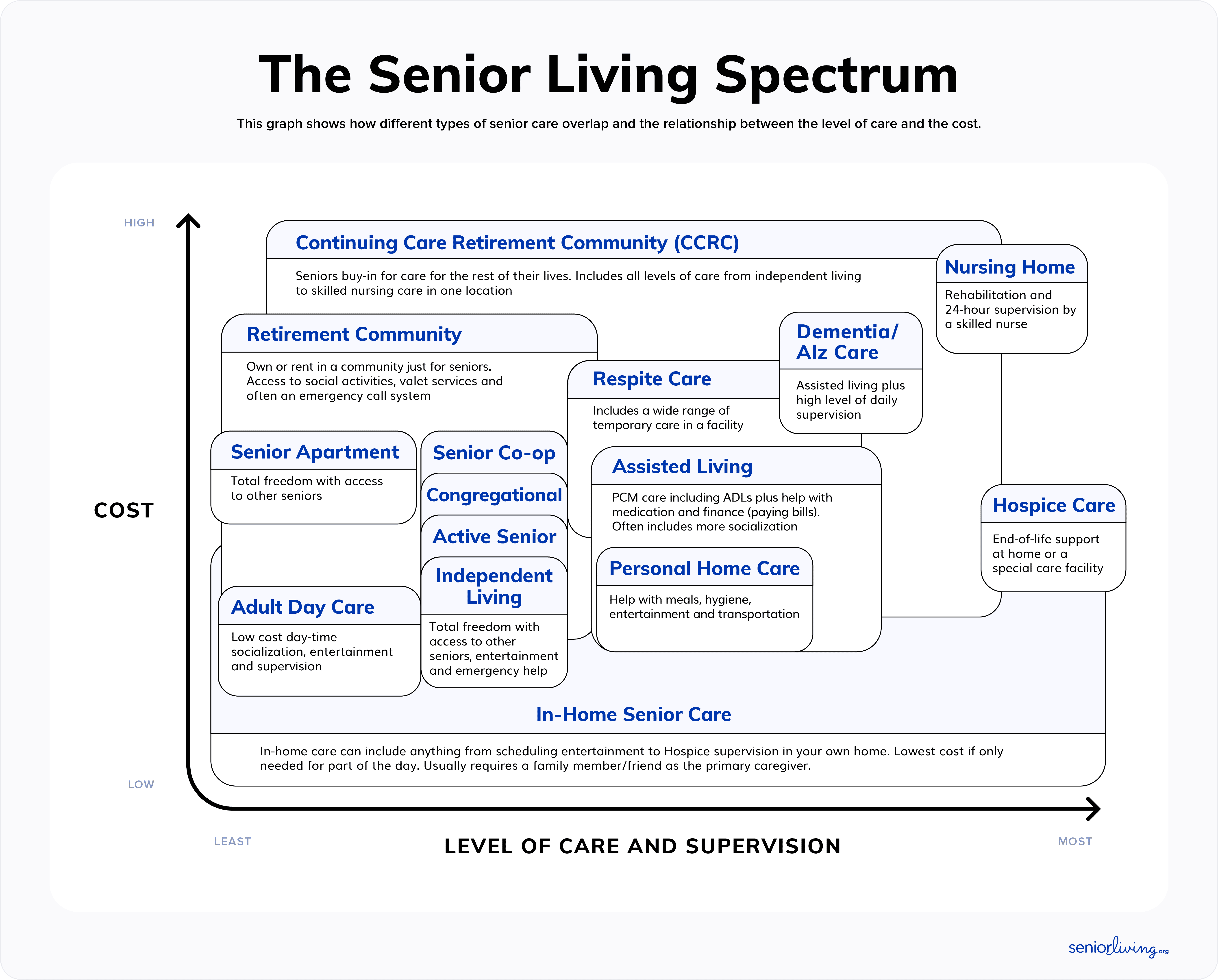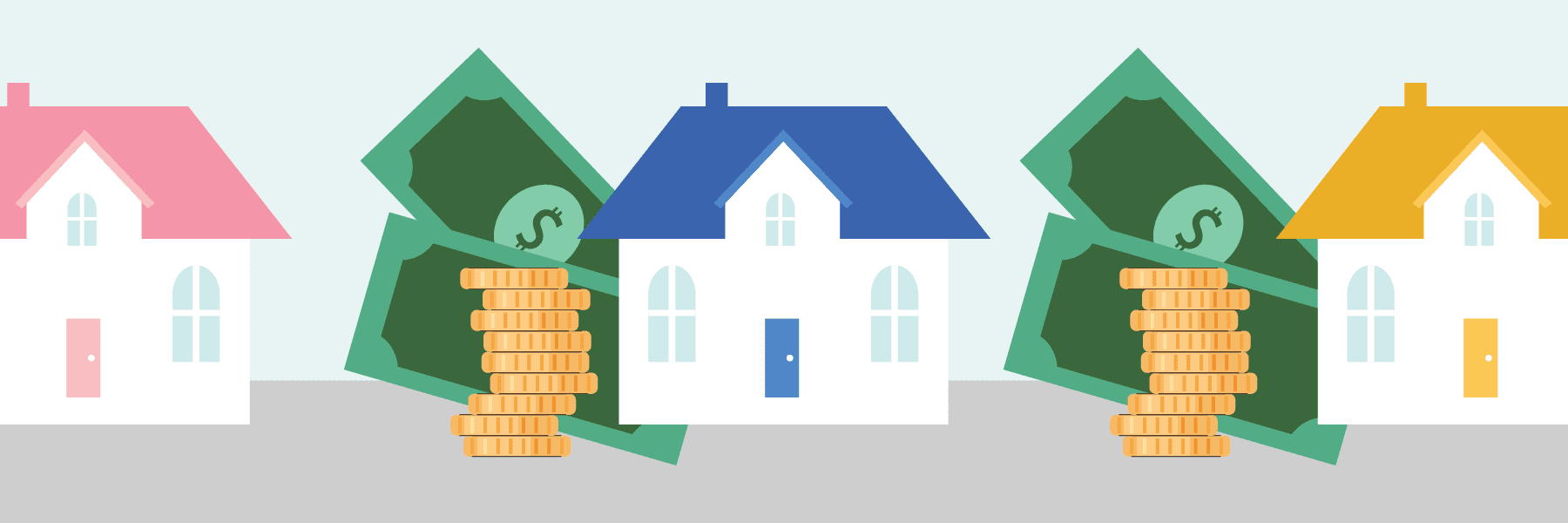Retirement Communities in 2025
Retirement communities, which come in many shapes and sizes, can help older adults build friendships, enjoy amenities designed for seniors, and live near others in a similar stage of life.
SeniorLiving.org is supported by commissions from providers listed on our site. Read our Editorial Guidelines
Find Retirement Communities Near You
Join 1,019,247 Seniors Who've Searched for Housing Communities on SeniorLiving.org.
Or Call: (855) 241-1699Find Retirement Communities Near You
“Retirement community” is a broad term covering many housing options for seniors. There are active senior communities, continuing care retirement communities, and age-restricted communities; lifestyle communities catering to Spanish-speaking seniors, RVers, or people of faith; and independent living communities. Though these communities vary, they’re all tied together by their residents: older adults who want to remain as independent as possible through their retirement years.
In this guide, we’ll look at different types of retirement communities, plus how to find and pay for your future retirement home.
Pro Tip: Visit our guide to planning for housing in retirement for tips on finding the best home for you, your lifestyle, and your budget.
What Is a Retirement Community?
A retirement community is designed just for older adults. What your house or apartment looks like, where it’s located, and how much it costs vary. However, we’ve found that all senior retirement communities offer four main features: security, convenience, senior-focused amenities, and a sense of community.
Security ranges from gated facilities to in-home emergency alarm response features. Conveniences include neighboring hospitals, shopping centers, an on-site restaurant, and nearby public transportation. Further, homes or apartment units may have easy-to-reach cabinet doors, higher toilets, open and single-level floor plans, and other features to make senior living easier.
And of course, there’s the fun stuff: amenities and friends! Amenities are based on age, abilities, and common interests of adults aged 55 and older. They might include fitness centers, craft classes, billiards rooms, walking trails, indoor/outdoor pools, tennis courts, golf courses, religious services, game nights, and many other ways to stay active. Depending on the community, residents may also be able to keep pets. All of this is offered in an environment where you can connect with other residents who are in the same stage of life.
Our free housing and care finder uses your unique needs to curate a list of the best options in your area.
Types of Retirement Communities
There are four main types of senior retirement communities:
- Assisted living retirement communities
- Independent living retirement communities
- Age-restricted retirement communities
- Lifestyle retirement communities
Assisted Living Retirement Communities
Assisted living retirement communities provide a moderate level of care. Seniors live in their own space (i.e., apartments, condos, or single-family dwellings). However, they also receive assistance with basic and vital needs, such as help with getting dressed, meal preparation, taking medication, and transportation.
According to the National Center for Assisted Living, these communities may also specialize in dementia care or provide tailored care for certain diseases, especially if they are a continuing care retirement community. These diseases include diabetes, depression, and cardiovascular disease. Keep in mind that an assisted living facility doesn’t provide most healthcare services directly. However, these facilities will work with healthcare providers, such as dentists, hospice nurses, podiatrists, counselors, and physical therapists. So you still benefit from specialized care while living in assisted living, rather than having to move to a nursing home or inpatient setting.
Independent Living Retirement Communities
Simply put, independent living communities are designed for active, healthy seniors who can live on their own. You can live in a home, townhouse, condo, or even a mobile home or motorhome. You can own, rent, or live as part of a cooperative. Think of it like living in your old neighborhood, except these communities have age restrictions — usually over 55 — and most offer amenities like clubhouses, gyms, yard maintenance, housekeeping, and security. Independent living communities also typically offer transportation, laundry service, group meals, and social and cultural activities.
Independent living communities also typically offer transportation, laundry service, group meals, and social and cultural activities.
Age-Restricted Retirement Communities
Age-restricted communities are often marketed to certain ages, such as 55+ communities. Some communities — marketed as “age-qualified”— require at least one person who is 55 to live in at least 80 percent of the occupied units. The U.S. Department of Housing and Urban Development (HUD) and the Fair Housing Act regulate these properties.1 Individuals under the age of 19 also cannot be permanent residents.
Pro Tip: Not sure if a retirement community is right for you? Check out our senior housing guide to learn about other options that might be a better fit for you.
Communities that market to a certain age group without formal age restrictions are called “age-targeted.” These communities focus on the senior demographic with amenities and conveniences, but anyone can live there regardless of age.
Lifestyle Retirement Communities
By 2030, all baby boomers will be at least 65 years old, so the demand for retirement communities is greater than ever.2 That’s why you can find senior living options for a wide variety of lifestyles. Here’s a sampling of some specialized retirement communities:
- University and college-based retirement communities: Some American colleges, like Duke University and Dartmouth College, sponsor university retirement communities that neighbor college campuses and provide seniors with advanced educational opportunities. Seniors don’t need to be alumni to move into a college’s retirement community.
- Faith-based retirement communities: Along with providing typical senior living amenities such as a gym, dining services, and social activities, these communities offer religious and spiritual care. This may include on-site worship services, pastors, bible study, and religious holiday celebrations.
- Golf retirement communities: Spend your retirement years hitting the green and befriending fellow golfers by living in an active adult community on a golf course. Florida, South Carolina, and North Carolina house most of these communities, but you can find options in many states.
- Boating retirement communities: If boating is your thing, consider moving into a houseboat during your retirement years. This lifestyle works best for very active seniors who prefer living a simple life on the water. And it’s estimated that this housing option costs only about $6,000 per year.
- Artist retirement communities: Sometimes called senior arts colonies, these communities provide creative outlets, showcases, and continuing professional education for artists of all types. Some operate like colleges, with different courses offered each semester. Classes might include dance, poetry, film and video editing, and life drawing.
- LGBTQ+ retirement communities: These communities cater to seniors who identify as LGBTQ+ with the goal of ensuring they feel celebrated, heard, and included during their retirement years. They’re generally for active older adults aged 55 and older.
- Manufactured/modular home communities: Senior-friendly mobile home communities offer amenities and services geared toward older adults. In many cases, no one under the age of 55 is permitted to live there. Great for life on a fixed income, many charge only $200 to $300 per month for the lot (plus the cost of your home).
- Luxury apartments: Seniors with money to spend can feel like they’re on vacation all the time by moving into a luxury retirement community. Along with high-end units, these communities offer gourmet kitchens, salons and spas, housekeeping services, golf courses, swimming pools, and 24-hour concierge services. You can also find luxury assisted living, nursing homes, and memory care facilities.
- Senior cooperative housing: With this housing type, the co-op is a corporation, and residents own stock in the corporation, becoming shareholders. In exchange, they live in one of the units; gain access to shared spaces, such as fitness rooms, libraries, and laundry facilities; and have a say in how the community is run. Most are in Minnesota, but you can find co-ops in several states.
Tips for Choosing a Retirement Community
When choosing the best type of retirement community for your needs, consider the options available to you based on location, financial resources, level of care, and expectations.
Location
Many retirement communities provide everything you need within the community. However, that doesn’t mean you should overlook the location. Consider the proximity of the community to:
- Friends and family
- Your house of worship or a similar house of worship
- Your doctors or a comparable hospital system
- Transportation, such as airports, grocery stores, train stations, and public buses
- Recreational opportunities that align with your interests, such as the ocean, mountains, hiking trails, etc.
And, of course, you can’t forget about the weather! Assess how you feel about staying in the same climate or moving to a different one. Many older adults find themselves drawn to warm-weather states during retirement to avoid the safety risks that come with snowy, icy weather. The location you choose could also come with financial incentives. For example, 29 states don’t tax Social Security benefits, and another eight don’t have income tax at all.3
Financial Resources
Moving into a retirement community can be costly. Finances won't necessarily affect your choice if you have unlimited funds and are an active senior. Choose between luxury retirement communities, active senior communities, and continuing care retirement communities (CCRCs) anywhere in the nation.
For seniors who live on a fixed income, note that most CCRCs have two major fees: a one-time lump sum to pay for the housing and a place within the facility (this ranges from $100,000 to $500,000 at the more modest senior retirement communities) and a monthly fee that covers services such as food, housekeeping, and activities.
If you are considered low-income, look for affordable senior housing. HUD housing programs and nonprofit housing organizations provide low-income housing to seniors who meet specific eligibility requirements. If you qualify for a HUD housing voucher, you’ll pay no more than 40 percent of your adjusted income on rent and utilities.3 The government will subsidize the rest.
>> Related Reading: 10 Places to Retire for $2,000 or Less
Level of Care
Many retirement communities cater exclusively to active older adults. They may or may not offer assisted living services, such as meals, laundry assistance, and help with activities of daily living (ADLs). Others, like CCRCs, offer increased care services and supervision as your needs change. For example, you can move from independent living into assisted living in a nursing home within the same community. This cuts back on moves and helps you maintain social connections even as you require more care.
We understand that navigating long-term care can be confusing. But it doesn’t have to be! Read our guide to long-term care for seniors to learn more about your many options.
Consider the type of care you currently need and anticipate in the future. Then, compare those needs to the services offered by a specific retirement community.
Expectations
Think about why you want to move out of your current living situation into a retirement community. What are you looking to gain? Make a checklist of what you want your retirement years to look like — everything from the amenities you’re excited about to the people you want to be around to the activities you’d like to pursue.
FYI: Have you considered retiring and living near the beach? You can find oceanfront and beachside retirement communities along the Atlantic Ocean, Pacific Ocean, and Gulf of Mexico.
You should also think through your expectations about the cost, size, layout, and feel of your new home or apartment. Some communities offer a choice between townhomes, single-family homes, and apartments. Others simply offer only one option.
Retirement House Communities
Retirement house communities are perfect for older adults who want to live in single-family housing. This type of senior housing can be found in specialty communities, such as university-based retirement communities, senior golfing communities, senior living co-ops, and CCRCs. You’ll be paying the mortgage on your home in addition to a Homeowners Association (HOA) or membership community dues.
In essence, you are living in a stand-alone home in a neighborhood where you have total freedom and autonomy. Your neighbors are all older adults who may have the same interests and lifestyles, allowing for a cohesive community. Your HOA will typically provide services geared toward older adults, such as inclusive lawn care and wheelchair-approved walkways and paths. This type of senior housing is best suited for individuals with a minimal level of care. However, you do have the flexibility to hire a private in-house nurse who can care for you in your home if needed.
Retirement Apartment Communities
The most common type of senior housing in retirement communities is apartment units. An apartment unit for luxury retirement communities is typically referred to as a condo. Meanwhile, low-income older adults can live in apartments commonly known as Section 8. Ultimately, with a senior retirement apartment, you would be living in a building where all (or at least 80 percent of) the residents are seniors over the age of 55.
Living in an apartment for seniors allows for a tight-knit community since the units are connected, allowing residents to interact more regularly. Apartment managers may also be hired to provide additional services, such as meal preparation or social activities.

SeniorLiving.org is supported by commissions from providers listed on our site. Read our Editorial Guidelines
Paying for a Retirement Community
Seniors who move into retirement communities may incur a few different expenses:
- Initial buy-in or home purchase: A lump-sum payment to purchase shares in a co-op or to buy a home in a retirement community
- Rent: Monthly apartment rent or lot rent fee in a senior mobile home park
- HOA or membership community fees: Yearly or monthly fees that go toward the homeowners association, maintaining community spaces, activities, etc.
Perhaps you already know how you’ll cover those expenses. Or you might still be trying to figure it out. Either way, let’s take a look at common ways that seniors pay for living in a retirement community:
- Reverse mortgage: Some homeowners take out a reverse mortgage on their primary home or property. Then, they use their home equity as cash to pay for a home in a retirement community.
- Property sale: Other homeowners sell their primary home outright and use the proceeds to cover the cost of their new home.
- Social Security and retirement income: The average Social Security benefit as of January 2024, was approximately $1,771 per month.5 Many older adults use this along with other retirement income to make monthly apartment rent payments or pay HOA fees.
- Housing vouchers and charitable organizations: Low-income seniors might qualify for government housing vouchers or housing assistance from nonprofit organizations. Typically, you’d pay no more than 40 percent of your adjusted income on rent and utilities.
- Family and friend contributions: Depending on your needs and financial situation, you may need to rely on help from friends and family.
- Combination of methods: In many cases, seniors who owe monthly rent for their retirement community or assisted living facility cover their bills with funds from several of the above sources as well as savings and investment accounts.
Questions to Ask When Touring Retirement Communities

Here are some considerations and questions to ask as you tour a retirement community:
- Talk to residents. Do they live there part-time or all year round? Are they happy with where they live? What do they dislike about the community? Were there any surprises? Is the property management company responsive to issues or requests?
- Ask the residents about the HOA. Do they attend meetings? If so, how are the meetings held? Do residents get ample time to speak?
- Is the developer financially solid? Are there resources in place to resolve any construction issues? What are the plans for further development? Have they built other communities? How are those communities functioning?
- Is there a reserve fund (aka “sinking fund”) for maintenance? This is set aside money for repairing or replacing things like roofs and air conditioning systems. This fund is typically a line item on the HOA’s budget.
- If there is surrounding, undeveloped property, who owns it, and how will it be used in the future? Is it a commercial property? Mixed-use? You probably don’t want a shopping center or airport built on the adjacent land.
- Get a copy of the HOA’s bylaws. Are there any rules you couldn’t live with? Some communities won’t allow any changes (like painting or modifications) to the exterior of the property without HOA approval. Others won’t allow any flags — even the American flag — to be displayed outside.
If you’re unable to tour a community in person for whatever reason, call and ask to be put in touch with a current resident or a member of the HOA. That way you can get your questions answered from the comfort of your home as you compare the different communities you’re considering.
FYI: Some retirement communities offer virtual tours through their website or a mobile app. If you cannot tour in person, ask if this alternative is available.
How to Find a Retirement Community Near Me
Finding local retirement communities is as easy as doing a simple internet search for “retirement communities near me.” You can also take a look at our senior living directory. Simply type in your ZIP code and answer a few questions, like which senior living options you’re interested in. You’ll receive a curated list of options in your area (or the area that you’d like to move to).
Keep in mind that if you’re interested in a niche type of lifestyle retirement community, such as a faith-based or golf course community, you may not find options in every state. You’re better off searching by type rather than focusing solely on communities in a single location; for example, “senior golf course retirement communities” or “Jewish senior living facilities.”
For low-income retirement communities, contact your local HUD public housing authority. It can help you with the application process. Plus, you can use tools on its website to find affordable rental units and public housing for seniors.
U.S. Department of Housing and Urban Development. (2023). THE FAIR HOUSING ACT: HOUSING FOR OLDER PERSONS.
Census.gov. (2019). 2020 Census Will Help Policymakers Prepare for the Incoming Wave of Aging Boomers.
Forbes. (2022). Which States Don’t Tax Retirement Income?
U.S Department of Housing and Urban Development. (2023). Housing Choice Vouchers Fact Sheet.
Social Security Administration. (2023). Social Security Fact Sheet.





